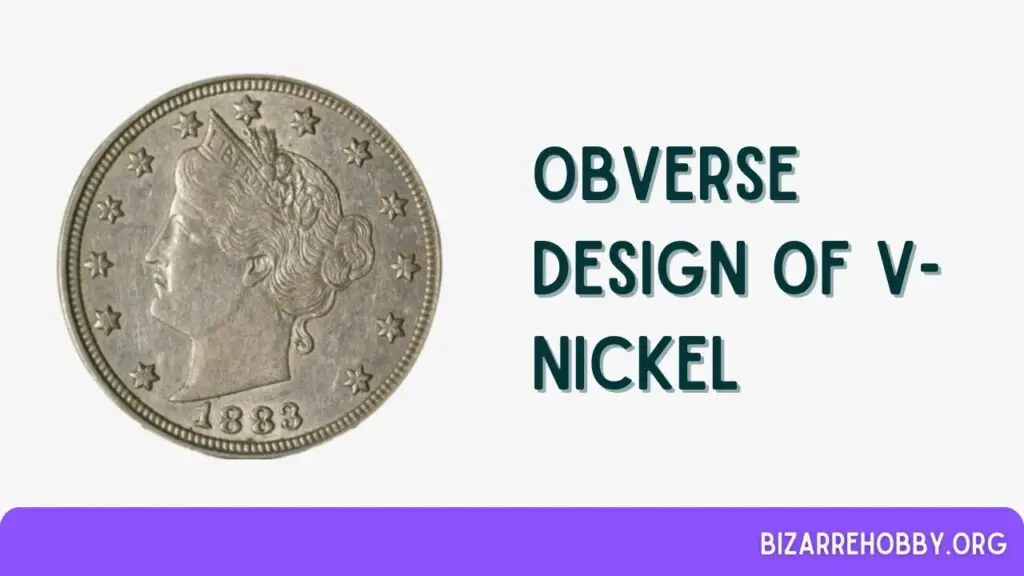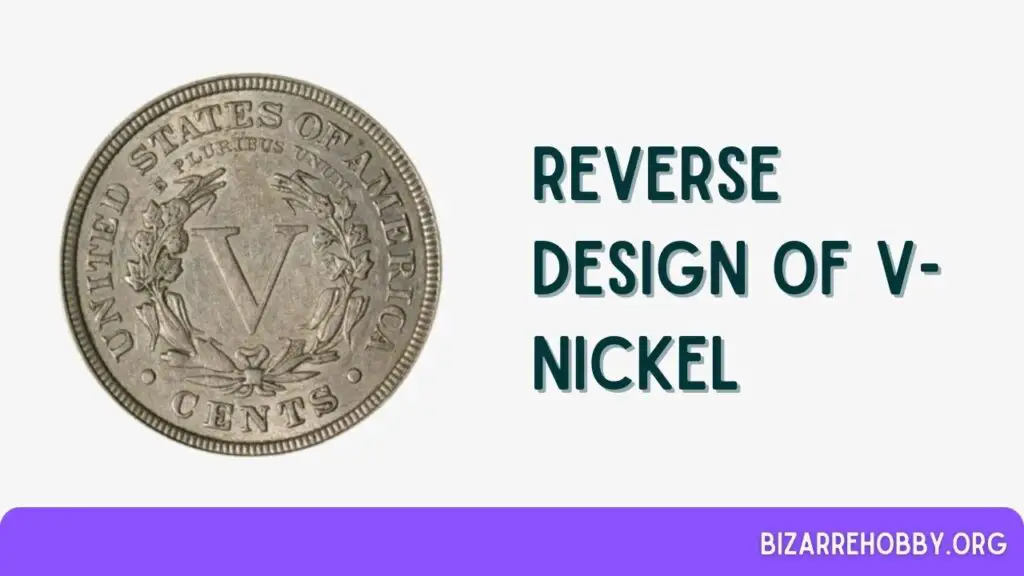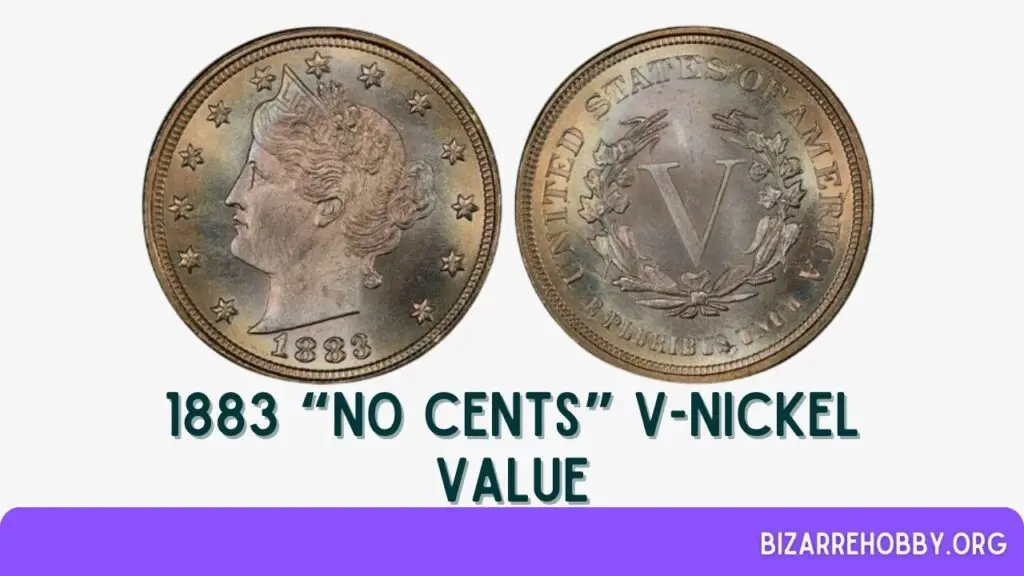Have you stumbled upon a nickel featuring a prominent “V” on one side? If so, you might have noticed that it’s over a century old. But is it valuable? And what could it be worth?
Let’s dive in to find out! We’ll explore the intriguing history behind this unique design of V-Nickels, examine the factors that influence the value of V-Nickels, and uncover some fascinating variants.
Ready to learn more? Let’s get started!
Table of Contents
Value Chart for V Nickel
| Mintage | VF20 | XF45 | MS60 | MS65 |
|---|---|---|---|---|
| 1883 “No Cents” V Nickel Value | $16 | $30 | $75 | $375 |
| 1883 “With Cents” V Nickel Value | $70 | $110 | $235 | $650 |
| 1885 V Nickel Value | $1,100 | $1,650 | $3,000 | $8,000 |
| 1886 V Nickel Value | $450 | $750 | $1,500 | $5,500 |
| 1895 V Nickel Value | $60 | $125 | $250 | $1,250 |
| 1900 V Nickel Value | $15 | $60 | $120 | $550 |
| 1912 V Nickel Value | $15 | $60 | $120 | $450 |
| 1912 D V Nickel Value | $50 | $200 | $400 | $1,350 |
| 1912 S V Nickel Value | $550 | $1,500 | $2,250 | $3,500 |
| Mintage | PR50 | PR60 | PR65 | PR67 |
|---|---|---|---|---|
| 1883, 1885 Proof V Nickel Value | $700 | $1,050 | $1,750 | $3,500 |
| Cameo: $1,750 | Cameo: $5,750 | |||
| Cameo: $1,200 | Deep Cameo: $3,000 | Deep Cameo: $22,500 | ||
| 1884 Proof V Nickel Value | $120 | $250 | $550 | $1,600 |
| Cameo: $800 | Cameo: $3,750 | |||
| Deep cameo: $2,000 | Deep cameo: $27,500 | |||
| 1895 Proof V Nickel Value | $250 | $550 | $5,000 | |
| NA | Cameo: $300 | Cameo: $800 | Cameo: $17,500 | |
| 1900 Proof V Nickel Value | $250 | $550 | $1,600 | |
| NA | Cameo: $300 | Cameo: $800 | Cameo: $3,250 | |
| 1913 Proof V Nickel Value | NA | NA | $5,500,000 | NA |
Historical Background of 1883-1913 V-Nickel

The nickel with the large “V” on the reverse is widely known among coin collectors as the “Liberty Head Nickel.” This nickname stems from the image on the obverse side, which features Lady Liberty in profile.
The first of these nickels were minted in 1883, with general production ceasing in 1912. However, in 1913, five proof nickels were struck, seemingly in secret.
Like its predecessor, the Shield Nickel, the V Nickel was composed of a copper-nickel alloy. The Shield Nickel had been challenging to strike successfully, prompting its replacement.
Initially, there were plans to produce new 1, 3, and 5-cent pieces simultaneously. The Mint’s Chief Engraver, Charles Barber, designed all three denominations, but only the nickel went into production.
The original specifications for the new nickel called for a diameter of 22 millimeters. Barber created patterns based on this size. However, it was later decided to reduce the diameter to 21.21 millimeters, closer to the Shield Nickel’s 20.5 millimeters. This new size soon led to issues.
The word “cents” was not included on the reverse of the nickels, as both 1 and 3-cent pieces had circulated for years without it. However, the new nickel’s size was similar to that of the gold 5-dollar coin. Clever fraudsters quickly exploited this, plating the nickels in gold and passing them off as the higher denomination.
One notorious scammer reportedly used these coins to buy items worth 5 cents, often receiving $4.95 in change. He couldn’t be charged with a crime, as he could argue that he had tendered the correct amount, and the change was a gift.
The Mint was understandably alarmed by this turn of events. Production of the nickel was halted, and new dies were created with the word “cents” added to the denomination.
The public responded by hoarding the “no cents” variety, anticipating that the Mint would recall them, making them valuable collectors’ items. However, this recall never happened. Today, the “with cents” variant of the 1883 mintage is rarer and more valuable.
By 1900, the rapidly growing US economy increased the demand for nickels, which were widely used in coin-operated machines.
For many years, the law required all nickels to be struck at the Philadelphia Mint. However, in 1906, legislation was relaxed to allow production at other locations. It wasn’t until 1912 that nickels were minted outside Philadelphia, with the first coins produced in Denver and San Francisco.
Designs of 1883-1913 V-Nickel
The V Nickel, minted between 1883 and 1913, is a fascinating piece of American numismatic history. Known for its distinctive design and historical significance, this coin has several unique features that make it a favorite among collectors.
From its initial production to its various design changes, the V Nickel offers a rich tapestry of stories and characteristics that reflect the era in which it was created. Let’s delve into the specifics of this intriguing coin.
Obverse Design of V-Nickel

The obverse, or “heads” side, of the V Nickel is what gives the coin its alternative name, the “Liberty Head Nickel.” This side features the profile of Lady Liberty, facing left. The design was crafted by Charles Barber, who served as the Mint’s Chief Engraver from 1879 to 1917.
Barber was tasked with creating similar designs for the penny, 3-cent piece, and nickel, all featuring a classical representation of Liberty, the word “LIBERTY,” and the date.
On the V Nickel, “LIBERTY” is inscribed on the diadem worn by Lady Liberty. The coin’s circumference is adorned with stars representing the states, and the date is positioned at the bottom, curving along the lower edge.
Reverse Design of V-Nickel

The reverse side of the initial 1883 V Nickels prominently displays a large “V,” the Roman numeral for five, at its center. Below the “V” is a wreath, and beneath that, the Latin motto “E PLURIBUS UNUM,” meaning “From the many, one,” symbolizing the union of states.
The top of the coin features the words “UNITED STATES OF AMERICA,” arching along the upper edge. In response to fraud issues, the Mint revised the design in June 1893, adding the word “CENTS” at the bottom and moving “E PLURIBUS UNUM” to the top, just below the country’s name.
Until 1912, all V Nickels were struck at the Philadelphia Mint and bore no mint mark. However, in 1912, production expanded to Denver and San Francisco, with coins from these mints marked with a “D” or an “S,” respectively. The mint mark is located to the left of the word “CENTS.”
Technical Specifications of V-Nickel
In its natural state, the V Nickel has a silver color and a plain edge. However, some 1883 coins were gold-plated by fraudsters attempting to pass them off as 5-dollar pieces.
Some of these altered coins also had reeded edges—grooves running parallel to the coin faces—added to mimic the appearance of 5-dollar coins. Ironically, reeded edges were originally developed as an anti-fraud measure to reveal if metal had been clipped from the coin’s edge.
Grading Guide for V-Nickel
Grading is essential to determine the exact value of your V Nickel. Here are the grades:
| Sheldon Scale | Grade |
|---|---|
| 1 | Basal State-1 |
| 2 | Fair |
| 3 | Very Fair |
| 4, 5, 6 | Good |
| 7, 8, 10 | Very Good |
| 12, 15 | Fine |
| 20, 30 | Very Fine |
| 40 | Extremely Fine |
| 50 | About Uncirculated |
| 60 | Mint State |
| 65 | Mint State |
| 70 | Mint State |
Please refer to our grading guide for Liberty Nickel to accurately assess your coin’s condition, which is a crucial step in determining its value.
V-Nickel Values Guides
Understanding the value of V Nickels from 1883 to 1913 requires a deep dive into their unique history and the various factors that influence their worth. From the initial “No Cents” variety to the rare proof coins, each type of V Nickel has its own story and value range.
This guide will help you navigate through the different variants and their respective values, ensuring you have a comprehensive understanding of what makes these coins so special.
1883 “No Cents” V-Nickel Value

The first V Nickels entered circulation on February 1, 1883. However, the absence of the word “cents” on these coins made them an easy target for fraudsters. Many of these nickels were gold-plated and passed off as 5-dollar pieces.
After five months, the Mint halted production to redesign the reverse, adding the word “CENTS” at the bottom and moving the Latin motto “E PLURIBUS UNUM” to the top.
The “No Cents” nickels, minted from February to June 1883, saw a production of nearly 5.5 million coins. Due to the fraud issues, many people hoarded these coins, expecting them to become valuable collectibles.
As a result, more of these coins survive in excellent condition compared to the “With Cents” variety.
A coin graded VF20 (Very Fine) can be acquired for around $16, increasing to $30 at XF45 (Extremely Fine). Mint state coins, which have never been circulated, start at $75 for MS60 and rise to $375 at MS65, the lowest grade considered a “gem.”
The finest examples, graded MS67+, have been certified by the PCGS, with 15 such nickels valued at $5,000 each.
1883 “With Cents” V-Nickel Value

The “With Cents” variant of the 1883 V Nickel was produced in much larger quantities, with over 16 million coins minted in Philadelphia.
Approximately 30,000 of these coins survive in various grades, but only about 2,000 are in mint state, a tenth of the number of “No Cents” examples. Gem quality examples are even rarer, with only around 500 known, compared to about 5,000 of the “No Cents” variety.
At all grades, the “With Cents” variant commands higher prices. A VF20 coin is valued at around $70, rising to $110 at XF45, and $235 at MS60. A gem MS65 example is worth approximately $650.
The highest graded coins, MS67+, are valued at $25,000 each by the PCGS.
Business Strike V-Nickels Key Dates Values
Certain V Nickel mintages are particularly sought after by collectors, including the 1885, 1886, and 1912 S. These years saw significantly lower production numbers compared to other years.
In 1886, 3.3 million coins were minted in Philadelphia, while in 1885, fewer than 1.5 million were produced. The 1912 S mintage was the lowest, with just 238,000 coins. However, fewer 1885 nickels were saved, making them generally more valuable.
An 1885 V Nickel graded VF20 is valued at $1,100, rising to $1,650 at XF45, and $3,000 at MS60. The finest examples, graded MS67, are valued at $35,000 each.
For an 1886 nickel, prices start at $125 for a coin graded 2, rising to $450 at VF20, and $750 at XF45. Mint state examples start at $1,500, with the finest MS67 coins valued at $75,000 each.
The 1912 S nickels start at $120 for a coin graded 2, with mint state examples beginning at $2,250. The highest graded coins, MS66+, are valued at around $12,500 each.
1883 Proof V-Nickel Values

The Mint produced proof nickels annually from 1883 to 1912. Values range from around $250 for PR60 examples to $600 at PR65. The finest coins in each mintage command a premium, with some years being particularly valuable.
The 1883 and 1885 proof nickels start at around $700 for coins graded 50, rising to $1,050 at PR60, and $3,500 at PR67. Proof coins assessed as cameos or deep cameos command even higher premiums, with PR67 deep cameos valued at around $22,500.
The rarest V Nickels are the five proof coins believed to have been secretly produced in 1913. The lowest graded of these coins, AU55, is valued at $2.5 million, while the top graded PR66 coin is valued at an astounding $6.25 million.
Where to Sell Your 1883 V-Nickel?
Now that you have a good understanding of your V Nickel’s value, the next step is finding the best place to sell it online. To make this process easier, I’ve compiled a list of reputable sites where you can sell your coins, along with their introductions, pros, and cons.
What to look for in 1883-1913 V-Nickel?
When evaluating a V-Nickel from 1883 to 1913, several key factors can significantly influence its value:
- Condition: The coin’s grade is paramount. Coins in mint state (MS) with minimal wear are more valuable. Look for sharp details in Lady Liberty’s hair and the wreath on the reverse.
- Mint Mark: Check for mint marks, especially the “S” for San Francisco and “D” for Denver, which can increase a coin’s rarity and value.
- Date and Variety: Certain years, like 1885, 1886, and 1912-S, are particularly rare. The 1883 “No Cents” and “With Cents” varieties also have different values.
- Errors and Variants: Coins with minting errors, such as double strikes or off-center strikes, can be highly sought after by collectors.
- Proof Coins: Proof versions, especially those from 1913, are extremely rare and valuable. Look for a mirror-like finish and sharp details.
By paying attention to these aspects, you can better assess the potential value of your V-Nickel.
What is a 1912 V Nickel worth?
The value of a 1912 V Nickel varies based on its condition and mint mark. The most valuable is the 1912-S, identifiable by the “S” on the reverse, to the left of the word “CENTS.”
- No Mint Mark: In poorer condition, these nickels are worth only a few dollars. In mint state, they can fetch over $100.
- D Mint Mark: These start at around $10 and increase in value with better condition.
- S Mint Mark: Even in the poorest condition, a 1912-S nickel is worth at least $120. The finest examples, graded MS66+, can be valued at $12,500 each.
FAQs on V-Nickel Value
What is the most valuable V Nickel?
The most valuable V Nickels are the 1913 editions. Only five are believed to exist, with values ranging from $2.5 million to $6.25 million.
Final Thoughts
The V-Nickel, minted from 1883 to 1913, is a fascinating piece of American numismatic history.
Whether you’re a seasoned collector or a curious beginner, understanding the factors that influence the value of these coins can enhance your appreciation and potentially your investment.
From the intriguing “No Cents” variety to the rare 1913 proofs, each V-Nickel tells a unique story.
![V-Nickel Value [1883-1913] - BizarreHobby](https://bizarrehobby.org/wp-content/uploads/2024/08/V-Nickel-Value-1883-1913-BizarreHobby.jpg)